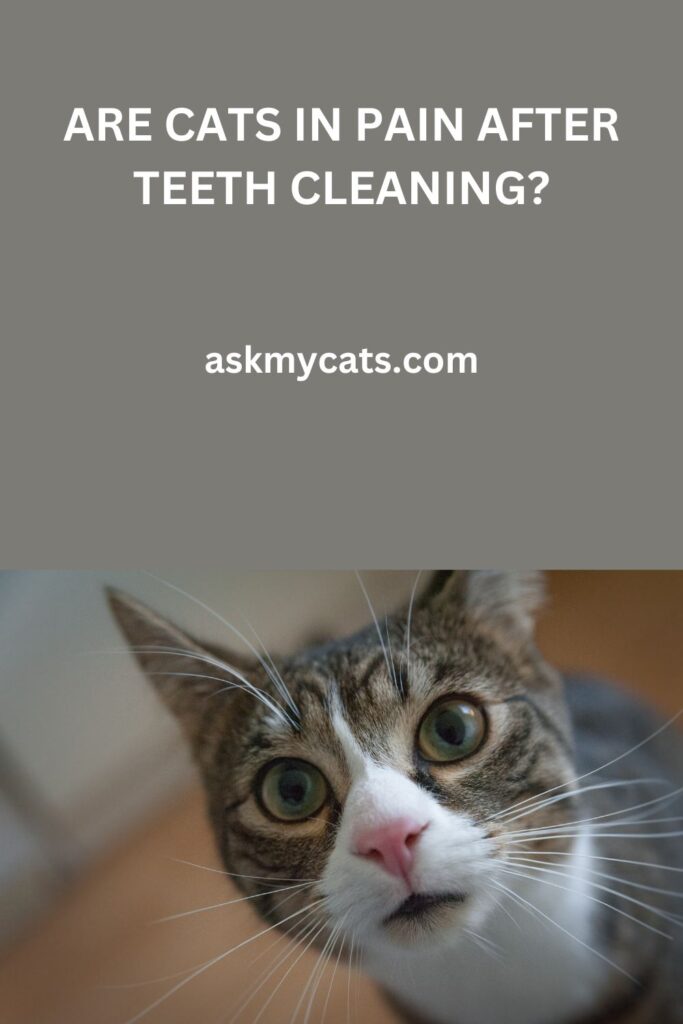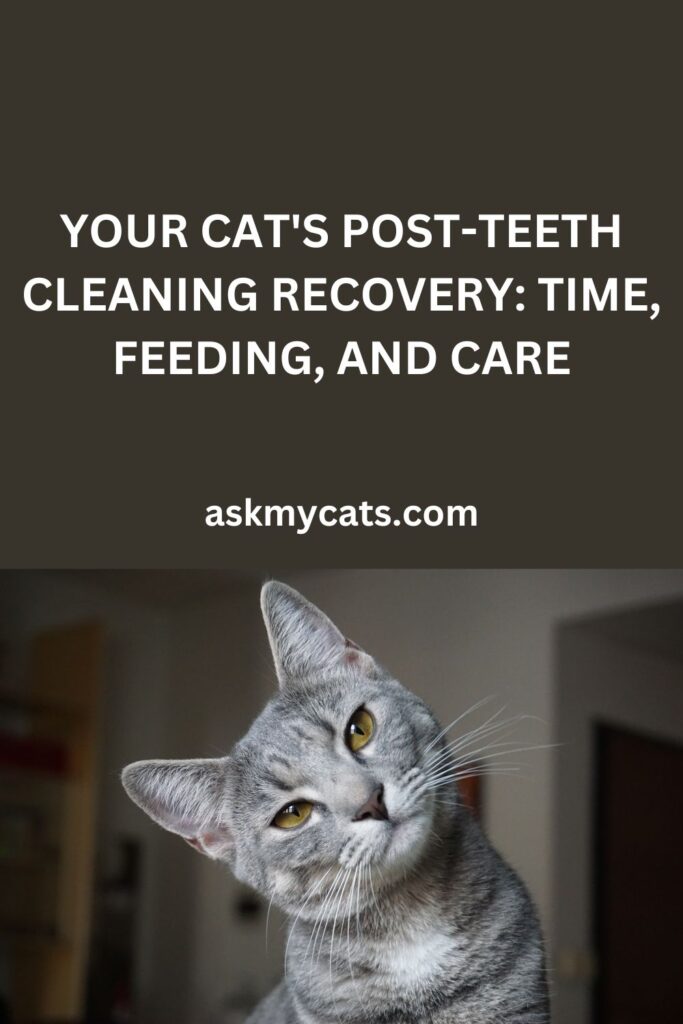Cat owners understand the importance of maintaining their furry companions’ oral health. Regular teeth cleaning is an essential part of preventing dental problems and promoting overall well-being.
However, many cat owners have concerns about their pets’ behavior and comfort after undergoing a dental cleaning procedure.
In this article, we will explore what happens to cats after teeth cleaning, addressing common questions and providing helpful tips for post-cleaning care.
Key Takeaways
- Cat behavior after teeth cleaning may vary, with some cats being lethargic or groggy.
- Excessive drooling, pawing at the mouth, or reluctance to eat may indicate discomfort.
- Soft or liquid diets may be recommended temporarily for easy consumption.
- Monitor for signs of pain or abnormal behavior during recovery; contact the veterinarian if necessary.
- Soft foods, encouraging water intake, and avoiding hard treats/toys aid in recovery.
- Consult the veterinarian for concerns or complications during the recovery process.


Give Your Cat the Perfect Day
Get the Free Ebook!
Are Cats In Pain After Teeth Cleaning?

It’s important to note that cats should not experience pain or discomfort after a dental cleaning.
The cleaning itself is performed under anesthesia, ensuring that the cat remains comfortable and unaware of the procedure. The anesthesia also prevents any potential stress or anxiety during the cleaning process.
But post-teeth cleaning behavior in cats can vary from one individual to another. While some cats may bounce back quickly and exhibit their usual energy levels, others may appear more lethargic or groggy.
This behavior is primarily due to the sedatives administered during the procedure, which help keep the cat calm and still.
However, it’s essential to observe your cat closely during the recovery period. Excessive drooling, pawing at the mouth, or showing reluctance to eat could indicate underlying issues or discomfort.
While mild drooling can be normal after a dental cleaning, persistent or excessive drooling should be brought to the attention of your veterinarian.
Reluctance to eat immediately after a dental cleaning is not uncommon. Cats may still feel groggy from the sedatives, which can affect their appetite. It’s important to offer your cat food and encourage them to drink water, but don’t be alarmed if they don’t eat right away.
If your cat continues to refuse food or shows prolonged loss of appetite, it’s essential to consult your veterinarian for further guidance.
Your Cat’s Post-Teeth Cleaning Recovery: Time, Feeding, and Care

The recovery time for cats after teeth cleaning can differ from one cat to another. While some cats may bounce back quickly within a day, others may take a few days to fully recover.
The use of anesthesia during the procedure may cause grogginess, which can temporarily affect your cat’s energy levels and behavior.
It’s important to provide a calm and comfortable environment for your cat during this recovery period.
Following your veterinarian’s feeding instructions is crucial for your cat’s recovery after teeth cleaning. Some cats may not feel like eating immediately after the procedure due to the lingering effects of anesthesia or minor discomfort.
It’s important not to force-feed your cat during this time. Instead, offer them food and water and allow them to eat at their own pace.
Some Common Feeding Instructions
Soft or Liquid Diet: Depending on your cat’s specific needs, your veterinarian may recommend a soft or liquid diet for a few days after the teeth cleaning procedure.
Soft foods can include moist food, semi-moist food, or even kibble soaked in water to make it easier for your cat to consume. Liquid diets may involve watering down the cat’s regular food or providing specially formulated liquid diets.
The purpose of a soft or liquid diet is to aid in your cat’s recovery by providing easily digestible options. These diets can be gentler on your cat’s mouth, especially if they experience any minor soreness or sensitivity after the cleaning procedure.
Be sure to consult with your veterinarian to determine the best approach and duration for the diet.
Dental Treats and Oral Hygiene: To maintain your cat’s oral health between teeth cleanings, your veterinarian may recommend dental treats or toothbrushes. Dental treats are designed to promote dental hygiene by reducing plaque and tartar buildup.
However, it’s important to check the ingredients of these treats to ensure they are not too fatty or salty, as excessive consumption can lead to health issues.
Using a cat-specific toothbrush and toothpaste can also be an effective way to maintain oral hygiene. Regular brushing, as advised by your veterinarian, helps prevent dental problems and keeps your cat’s teeth and gums healthy.
Also read: Cat Teeth Cleaning Treats, Toys & Chews: Cat Dental Care Made Easy
Monitoring and Follow-up Care
During the recovery period, it’s crucial to monitor your cat for any signs of pain, discomfort, or abnormal behavior. If you notice excessive drooling, pawing at the mouth, or reluctance to eat persisting beyond a few days, it’s important to contact your veterinarian.
They can assess your cat’s condition and provide further guidance or adjustments to the post-teeth cleaning care plan.
Additionally, scheduling regular dental checkups with your veterinarian is essential to monitor your cat’s oral health and prevent future dental problems.
These checkups allow for early detection of any issues and ensure appropriate preventive measures are in place.
Must Read: Cat Teeth Cleaning Risks: What Every Cat Owner Should Know
Addressing Common Concerns About Cats’ Teeth Cleaning & Recovery

After a dental cleaning, it is not uncommon for cats to experience reduced appetite or reluctance to eat. This behavior can be attributed to various factors, such as grogginess from anesthesia or discomfort in the mouth.
While it is important to follow your veterinarian’s feeding instructions, it is equally important to address any concerns that may arise during your cat’s recovery process.
1. Offering Soft Foods:
To accommodate your cat’s reduced appetite or potential discomfort, providing soft foods can be beneficial.
Soft foods are gentler on the mouth and may be more appealing to cats during their recovery period. Ensuring that the food is at a suitable temperature can also increase its palatability.
2. Encouraging Water Intake:
Staying hydrated is crucial for your cat’s overall well-being, especially after a dental cleaning. You can encourage your cat to drink water by ensuring fresh and clean water is readily available.
If your cat is hesitant to drink, try providing water in different bowls or even using a pet water fountain, as some cats prefer moving water.
You can also consult your veterinarian for advice on using water additives or flavor enhancers that may entice your cat to drink more.
3. Avoiding Hard Treats or Toys:
During the recovery period, it is important to avoid giving your cat any hard treats or toys. Hard treats can be difficult for a cat with a sensitive mouth to chew, potentially causing discomfort or even damaging the teeth.
Similarly, toys that require biting or chewing should be temporarily avoided to prevent any strain on the mouth. Opt for softer and more gentle forms of enrichment, such as puzzle toys or interactive play sessions that do not involve excessive biting or chewing.
4. Consulting Your Veterinarian:
If your cat continues to refuse food or exhibits concerning symptoms during their recovery from teeth cleaning, it is crucial to consult your veterinarian. Persistent loss of appetite or unusual behavior could indicate underlying issues or complications.
Your veterinarian will be able to assess your cat’s condition, address any concerns, and provide appropriate guidance or adjustments to the post-teeth cleaning care plan.
Prompt veterinary attention will help ensure that your cat receives the necessary care for a smooth and successful recovery.
Interesting Read: The Importance of Teeth Cleaning for Older Cats
Long-Term Oral Health: Nurturing Your Cat’s Dental Well-Being
Ensuring long-term oral health for your beloved feline companion goes beyond just a single teeth-cleaning procedure. Regular dental checkups with your veterinarian play a crucial role in maintaining optimal oral health and preventing future dental issues.
These checkups allow for monitoring of your cat’s oral health, early detection of potential dental issues, and preventive measures to avoid future problems.
Your veterinarian may recommend therapeutic dental or oral care diets specifically formulated to control and decrease the incidence of dental disease.
Must Read: How to Brush a Cat’s Teeth: Step-by-Step Guide
Frequently Asked Questions
How often should I schedule dental checkups for my cat?
It is recommended to schedule dental checkups for your cat at least once a year. However, your veterinarian may suggest more frequent checkups based on your cat’s specific dental health needs.
What happens during a dental checkup for cats?
During a dental checkup, your veterinarian will examine your cat’s teeth and gums, looking for signs of dental disease or other oral health issues. They may also perform a professional cleaning if necessary, which involves removing plaque and tartar buildup from the teeth and below the gum line.
What are therapeutic dental or oral care diets?
Therapeutic dental or oral care diets are specially formulated diets that are designed to promote dental health in cats. These diets typically have a unique texture or shape that helps reduce plaque and tartar buildup, and they may contain ingredients that support oral health.
How do therapeutic dental or oral care diets help with dental disease prevention?
These diets work by mechanically removing plaque and tartar from the teeth as the cat chews. The texture or shape of the kibble helps to scrape off the buildup, reducing the risk of dental disease. Additionally, some diets may contain additives or ingredients that help control bacteria in the mouth, further supporting dental health.
Can I solely rely on therapeutic dental diets for my cat’s oral health?
While therapeutic dental diets can be beneficial for your cat’s oral health, they should not be the sole method of maintaining dental hygiene. Regular brushing with a cat-specific toothbrush and toothpaste, as recommended by your veterinarian, is still essential.
Final Words
Proper care and understanding of your cat’s behavior after teeth cleaning are vital for their well-being. While cats may experience temporary grogginess or changes in appetite, they should not be in pain or discomfort.
By following your veterinarian’s instructions, offering appropriate post-cleaning diets, and scheduling regular checkups, you can ensure your feline friend’s long-term oral health and overall happiness.
Remember, attentive care and proactive measures are key to keeping your cat’s pearly whites shining bright.
Check Out: How Much Does Cat Teeth Cleaning Cost?
